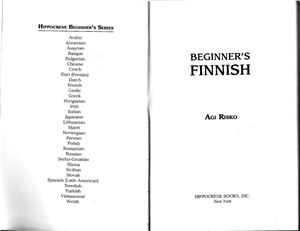Risko A. Beginner's Finnish. – NY. : Hippocrene books, inc. , 2004.
– 297p.
Introduction
so, you have decided to take a look at Finnish. Perhaps you are planning a trip to Finland and would like to lea a little of the language. Or, maybe you have just retued from there and feel frustrated at not having understood a word of what people were saying. Whatever the reason, you have picked up this book and are ready to give this beautiful, exotic language a try. Welcome.
This book will give you the tools for elementary communication in Finnish by providing an introduction to basic vocabulary and idioms, as well as grammatical structure. After completing the lessons, understanding the grammar and leaing the vocabulary, you will have at your disposal over 600 Finnish words and expressions, and the ability to combine them to communicate on a lower intermediate level.
The material has been divided into twelve chapters. The dialogues follow two American students, who are visiting Helsinki for the first time, in order to improve their Finnish language skills. Their adventures and conversations with two Finnish friends present snapshots of the fabric of life in Helsinki and in Finland during summer.
The dialogues are followed by their English translations and a word-by-word vocabulary list. In addition, all words are included in the Finnish-English/English-Finnish glossary at the back of the book. This glossary contains only the specific meaning of a word as used in the chapters. Donэt use the list as a general dictionary, but rather as a guide and aid to this particular text. Both nouns and verbs are in their basic forms. The numbers following nouns and adjectives refer to the inflectional groups, as listed in Appendix
1. The grammar section of each lesson provides an overview of the central structures and devices of Finnish. The explanations don't go into great detail. Rather, they give simple guidelines for understanding and using the main grammatical structures common in everyday communication. Each lesson ends with a series of exercises, the answers to which can be found at the back of the book. Appendix 2 contains the principal parts of all verbs that occur in the book.
Unlike students of Spanish, French or German, who discover that those languages share a large common vocabulary with English, you will find that Finnish words are strikingly different from those in English. There are not many words in everyday use that have been borrowed directly from English. Finnish is a puristic language, which means that it does not absorb foreign words readily; rather, it prefers to translate them. Therefore, plan on spending plenty of time working on vocabulary and memorizing words. This is always the coerstone of successful communication, since vocabulary is the core of every language.
Introduction
so, you have decided to take a look at Finnish. Perhaps you are planning a trip to Finland and would like to lea a little of the language. Or, maybe you have just retued from there and feel frustrated at not having understood a word of what people were saying. Whatever the reason, you have picked up this book and are ready to give this beautiful, exotic language a try. Welcome.
This book will give you the tools for elementary communication in Finnish by providing an introduction to basic vocabulary and idioms, as well as grammatical structure. After completing the lessons, understanding the grammar and leaing the vocabulary, you will have at your disposal over 600 Finnish words and expressions, and the ability to combine them to communicate on a lower intermediate level.
The material has been divided into twelve chapters. The dialogues follow two American students, who are visiting Helsinki for the first time, in order to improve their Finnish language skills. Their adventures and conversations with two Finnish friends present snapshots of the fabric of life in Helsinki and in Finland during summer.
The dialogues are followed by their English translations and a word-by-word vocabulary list. In addition, all words are included in the Finnish-English/English-Finnish glossary at the back of the book. This glossary contains only the specific meaning of a word as used in the chapters. Donэt use the list as a general dictionary, but rather as a guide and aid to this particular text. Both nouns and verbs are in their basic forms. The numbers following nouns and adjectives refer to the inflectional groups, as listed in Appendix
1. The grammar section of each lesson provides an overview of the central structures and devices of Finnish. The explanations don't go into great detail. Rather, they give simple guidelines for understanding and using the main grammatical structures common in everyday communication. Each lesson ends with a series of exercises, the answers to which can be found at the back of the book. Appendix 2 contains the principal parts of all verbs that occur in the book.
Unlike students of Spanish, French or German, who discover that those languages share a large common vocabulary with English, you will find that Finnish words are strikingly different from those in English. There are not many words in everyday use that have been borrowed directly from English. Finnish is a puristic language, which means that it does not absorb foreign words readily; rather, it prefers to translate them. Therefore, plan on spending plenty of time working on vocabulary and memorizing words. This is always the coerstone of successful communication, since vocabulary is the core of every language.

